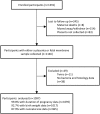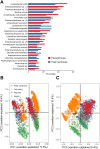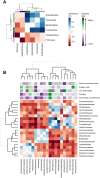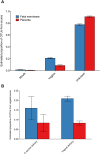Bacterial communities found in placental tissues are associated with severe chorioamnionitis and adverse birth outcomes
- PMID: 28700642
- PMCID: PMC5507499
- DOI: 10.1371/journal.pone.0180167
Bacterial communities found in placental tissues are associated with severe chorioamnionitis and adverse birth outcomes
Abstract
Preterm birth is a major cause of neonatal mortality and morbidity worldwide. Bacterial infection and the subsequent inflammatory response are recognised as an important cause of preterm birth. It is hypothesised that these organisms ascend the cervical canal, colonise placental tissues, cause chorioamnionitis and in severe cases infect amniotic fluid and the foetus. However, the presence of bacteria within the intrauterine cavity does not always precede chorioamnionitis or preterm birth. Whereas previous studies observing the types of bacteria present have been limited in size and the specificity of a few predetermined organisms, in this study we characterised bacteria found in placental tissues from a cohort of 1391 women in rural Malawi using 16S ribosomal RNA gene sequencing. We found that specific bacteria found concurrently on placental tissues associate with chorioamnionitis and delivery of a smaller newborn. Severe chorioamnionitis was associated with a distinct difference in community members, a higher bacterial load and lower species richness. Furthermore, Sneathia sanguinengens and Peptostreptococcus anaerobius found in both matched participant vaginal and placental samples were associated with a lower newborn length-for-age Z-score. This is the largest study to date to examine the placental microbiome and its impact of birth outcomes. Our results provide data on the role of the vaginal microbiome as a source of placental infection as well as the possibility of therapeutic interventions against targeted organisms during pregnancy.
Conflict of interest statement
Figures








References
-
- Blencowe H, Cousens S, Oestergaard MZ, Chou D, Moller A-B, Narwal R, et al. National, regional, and worldwide estimates of preterm birth rates in the year 2010 with time trends since 1990 for selected countries: a systematic analysis and implications. Lancet. 2012. June 9;379(9832):2162–72. doi: 10.1016/S0140-6736(12)60820-4 - DOI - PubMed
-
- Ashorn P, Alho L, Ashorn U, Cheung YB, Dewey KG, Harjunmaa U, et al. The impact of lipid-based nutrient supplement provision to pregnant women on newborn size in rural Malawi: a randomized controlled trial. Am J Clin Nutr. 2015. February 1;ajcn.088617. - PubMed
-
- van den Broek NR, Jean-Baptiste R, Neilson JP. Factors associated with preterm, early preterm and late preterm birth in Malawi. PloS One. 2014;9(3):e90128 doi: 10.1371/journal.pone.0090128 - DOI - PMC - PubMed
-
- Moore T, Hennessy EM, Myles J, Johnson SJ, Draper ES, Costeloe KL, et al. Neurological and developmental outcome in extremely preterm children born in England in 1995 and 2006: the EPICure studies. The BMJ. 2012. December 4;345:e7961 doi: 10.1136/bmj.e7961 - DOI - PMC - PubMed
Publication types
MeSH terms
Substances
LinkOut - more resources
Full Text Sources
Other Literature Sources

